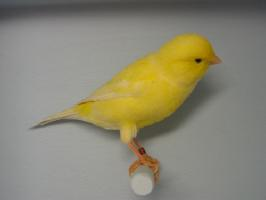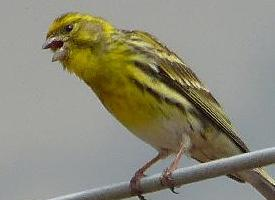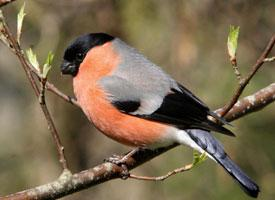
Ismert mint
- Kanár domácí
Súlyok és méretek
| Hossz | 12,5 cm |
|---|---|
| Súly | 15-tól 20-ig g |
Állatleírás
The Atlantic Canary (Serinus canaria), often simply known as the wild canary, is a small passerine bird belonging to the finch family, Fringillidae. Originating from the Macaronesian Islands, including the Canary Islands, Azores, and Madeira, this species has played a significant role not only in the natural ecosystem but also in human culture and history, most notably in the development of the domestic canary.Physically, the Atlantic Canary is a small bird, typically measuring between 12 to 13 cm in length and weighing around 15 to 20 grams. They exhibit a range of color variations, from greenish to yellow, with darker streaks on the back and lighter underparts. Males tend to have brighter plumage compared to females, especially during the breeding season, which is a common trait among many bird species as it plays a crucial role in attracting mates.
One of the most remarkable attributes of the Atlantic Canary is its melodious song. Males are known for their complex and beautiful singing, used both to attract mates and to mark territory. This singing ability has made them highly valued as cage birds from the time of the Greeks and Romans, leading to the widespread breeding and variation of the domestic canary.
In their natural habitat, Atlantic Canaries are adaptable and can be found in a wide range of environments, including gardens, orchards, and mountainous regions, up to the tree line. They are granivorous, with a diet primarily consisting of seeds, but they will also consume small insects and other greens. During the breeding season, which can vary significantly depending on the climate and location, they construct their nests in trees or bushes, where the female lays and incubates eggs.
Atlantic Canaries are social birds outside of the breeding season, often forming flocks that can include other finch species, showcasing their adaptability and sociability. Their status in the wild is currently of least concern, thanks to their wide distribution and large population. However, habitat destruction and climate change pose ongoing threats to their natural environments, which could impact their populations in the long term.
The introduction of the Atlantic Canary to various parts of the world has also led to the establishment of feral populations, particularly in regions such as Bermuda, Hawaii, and Puerto Rico. These introductions were largely accidental, often resulting from the release or escape of domesticated birds.
The cultural significance of the Atlantic Canary extends beyond its role as a pet. The Canary Islands, for instance, are named after the bird, not the other way around, with the Latin name "canaria" relating to dogs (canines), which the Romans reportedly found on the islands along with the birds. This historical intertwining with human civilization highlights the Atlantic Canary's enduring appeal and importance, both ecologically and culturally.
In summary, the Atlantic Canary is a small, vibrant bird with a rich history of interaction with humans, valued for its singing ability and contributing to biodiversity in its natural habitats. As a symbol of nature's music and beauty, it continues to captivate and inspire bird enthusiasts and nature lovers around the world.
Hasonló állatok
Új állatfotók
Top 10 állat
- Dolphin gull (Leucophaeus scoresbii)
- Japanese macaque (Macaca fuscata)
- Stone loach (Barbatula barbatula)
- Russian tortoise (Testudo horsfieldii)
- Galápagos tortoise (Geochelone nigra complex)
- Greek tortoise (Testudo graeca)
- Diana monkey (Cercopithecus diana)
- Common flying dragon (Draco volans)
- Moustached guenon (Cercopithecus cephus)
- Galápagos penguin (Spheniscus mendiculus)


